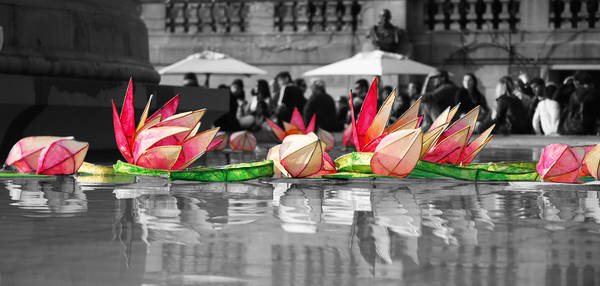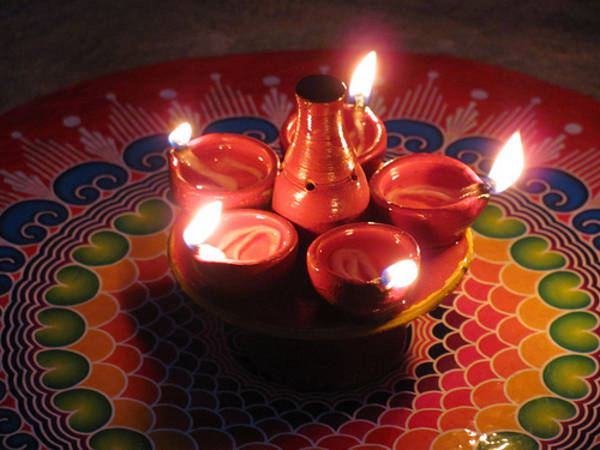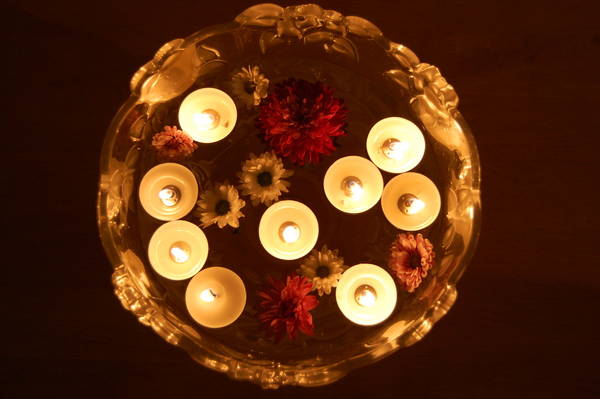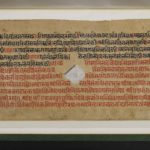Article: Dīvālī
Dīvālī – commonly spelled Diwali – or Dīpāvalī is the ‘Festival of Lights’. It is a holy date falling in late September or October for Hindus, Sikhs and Jains alike but their understanding of it is totally different. For the Jains, this annual festival commemorates Mahāvīra‘s final liberation. It unfolds in various stages and corresponds to the beginning of the new year.
The Dīvālī festival celebrates two apparently contradictory features – the desirability of renouncing the world and of worldly values such as wealth and well-being. It is celebrated by Śvetāmbaras and Digambaras alike.
Festival date and key events
The Dīvālī period is connected with two major events of the Jain tradition, which are both commemorated in the festival.
These are, firstly, Mahāvīra‘s final liberation and, secondly, Indrabhūti Gautama’s enlightenment. The celebration of the emancipation of the 24th Jina takes place on the 15th day of the dark half of Āśvina, roughly September to October. Gautama’s enlightenment is remembered on the first day of the bright half of Kārttika, roughly October to November. This day marks the New Year.
In early sources such as the Kalpa-sūtra, Mahāvīra’s death and liberation are precisely located and dated. His emancipation from the cycle of rebirth took place in Pāvāpuri, in modern-day Bihar.
During this monsoon halt, in the fourth month of the rainy season, in the seventh fortnight, in the dark half of Kārttika, on the fifteenth day, that being his last, during the night, the Venerable Ascetic Mahāvīra passed away, went off, quitted the world, cut asunder the ties of birth, old age, death, became perfected, enlightened and liberated, the maker of the end; he entered into liberation and ended all misery.
Translation by K. C. Lalwani, page 70
Following the liberation, various kings of the region began setting up lights, which they saw as substitutes for the spiritual illumination that the teacher embodied:
During the night when the Venerable Ascetic Mahāvīra passed away […], during that night, the night of the new moon, nine Mallaki kings, and nine Licchavi kings, in all 18 confederate kings, from Kāśī and Kośala respectively, instituted a spiritual practice name[d] pārābhoga-poṣadha and said: ‘As the light of intellect is gone out, so shall we light the light with material objects’.
Translation by K. C. Lalwan, page 72
The second event is described as well:
During the night when the Venerable Ascetic Mahāvīra passed away […], during that night, his senior disciple-monk Indrabhūti, of the Gautama line, was freed from the tie of attachment [towards the Master], and attained the supreme knowledge and faith, kevala by name, unprecedented, unobstructed, unlimited, complete and full.
Translation by K. C. Lalwani, page 71
As is customary, the date of Mahāvīra’s final liberation is given in the lunar calendar, but what is more noteworthy is that the year is also mentioned. It corresponds to 527 to 528 BCE, which marks the beginning of the Jain era known as Vīra-saṃvat, according to the Jain Śvetāmbara tradition. The year according to the Digambaras corresponds to 510 BCE.
Hindus and Sikhs celebrate Dīvālī on the same date as the Jains, but with a totally different understanding. Discussions, which can be considered relevant or pointless, have taken place about which religious group was the first to use this date for a festival of lights (see Gode).
The 2500th anniversary of Mahāvīra’s liberation
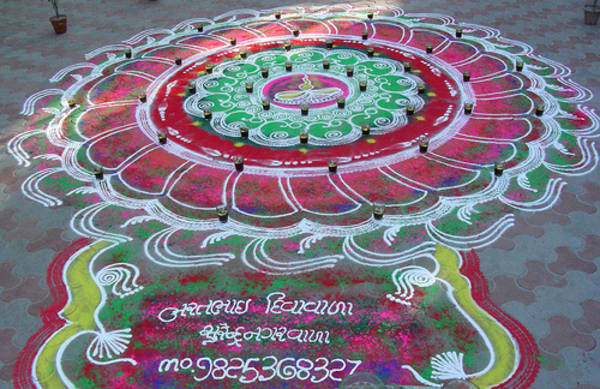
Dīvālī rangoli at Palitana
Image by liketearsintherain – Tommy © CC BY-SA 2.0
Each year all Jains celebrate the liberation of the 24th Jina, Mahāvīra. However, the commemoration of the 2500th anniversary, which took place on the 13th November 1974, was carried out with special pomp.
Jains actively carried it beyond being a community festival with the support of the Indian government. Presided over by the then Prime Minister, Mrs Indira Gandhi, a national committee was formed of representative Jains and non-Jains. Committees were also formed in the various states of India. These committees had various educational and intellectual objectives, namely:
- creation of a national park with arches and pillars inscribed with Mahāvīra’s teachings
- creation of a Jain museum
- creation of educational centres and libraries in the name of Mahāvīra
- establishment of a commemorative monument at Mahāvīra’s birthplace, Kshatriyakund, modern-day Vaishali in Bihar
The general aim of the committees was to ‘encourage people to think about the life and message of the great prophet’ (Upadhye 1974).
In fact, a Bhagavān Mahāvīra 2500th Nirvāṇa Mahotsava Samiti – the Association for the Great Celebration of the 2500th Anniversary of Lord Mahāvīra’s Emancipation – had been established as early as 1968. Intended to publish Jain books, the institution was set up at the initiative of the Mumbai Jain community. Indeed, various institutions published numerous books on this occasion, of various kinds and for different types of reader. See the section ‘Further reading‘ for some examples.
Main features of Dīvālī
In all Jain festivals, believers practise religious observances in the form of fasts and this is an important element of Dīvālī too.
Like the Śvetāmbara festival of Paryuṣaṇ or its Digambara counterpart, Daśa-lakṣaṇa-parvan, Dīvālī is:
- crucial to Jain identity and is thus observed everywhere, whether in India or in countries where Jains have settled
- lasts for several days and includes different events.
But, in practice, the festivals are somewhat different, although there is great local variation. For example, during Paryuṣaṇ the focus is on religious observances and austerities whereas in Dīvālī there is more emphasis on social gatherings, rejoicing and festive meals.
Taking place over several days, Dīvālī can be thought of as a ‘cluster of festivals’ (Cort 2001, page 164). It begins on the 13th day of the dark half of Āśvina and lasts till the first day of the bright half of Kārttika.
Worship of wealth
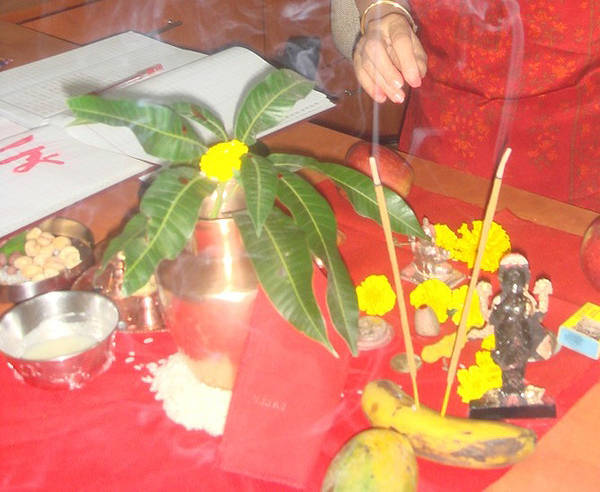
Offerings to Lakṣmī
Image by Bansri Mehta © Bansri Mehta
The opening ceremony of Dīvālī is known as Lakṣmī-pūjā or ‘Wealth 13th’. This rite of worshipping affluence is performed on the 13th day of the dark half of Āśvina, which is known as Dhanya-trayodaśī in Sanskrit or Dhanteras in Gujarati.
This ceremony varies immensely among different communities of Jains. The main feature is worship of the goddess Lakṣmī who is wealth incarnate and thus of great importance for Jain business communities. Some communities worship silver coins with materials normally used for religious images, such as incense or scented powder, and buy silverware and account books for the new year on this day (Cort 2001, page 164). Worship of the goddess is usually elaborate. Auspicious diagrams of coloured powder – rangolis – are drawn on the ground or walls, and temporary shrines made of leaves are erected in houses (Laidlaw 1995, pages 370 to 371). In some cases, ‘religious objects are all put together in what looks like a flagrantly syncretistic way’ (Laidlaw, page 372), but they used separately in the worship ceremonies.
Account books
As Dīvālī marks the end of the year and the beginning of a new one, Jain businessmen and women open new account books. Among Jain merchants, these account books are objects with religious significance.
The account books start with an invocation to Mahāvīra and Indrabhūti Gautama, who is called Gautam Swami in modern parlance. These two are the key individuals in Dīvālī celebrations. In many respects, Gautam Swami is equated with the Hindu god Gaṇeśa, who has the same place in Hindu account books (see Laidlaw for more details).
The first page of the account books contains a list of virtues believed to be auspicious, each of them illustrated by a character known from the story literature. These lists vary, but six virtues are often mentioned (Laidlaw 1995, page 380 onwards):
- the magical powers of Gautam Swami
- the office or status of the universal monarch Bharata
- the prosperity of Dhanya and Śālibhadra, detailed in the Śālibhadra-caupaī story
- the intelligence of the minister Abhayakumāra
- the strength of Bāhubali
- the prowess of giving shown by Śreyāṃsa.
All these virtues are those that an ideal businessman or merchant should possess.
On this day shops are decorated, lights are lit everywhere in the streets and savoury food is prepared in abundance.
Fourteenth day
The 14th day of the dark half of Āśvina is considered an intermediate day, because it comes between the start of Dīvālī and the new year. It is known and celebrated in contrasting ways depending on the community.
The ‘Black Fourteenth’ or Kālī Caudaś is often thought to be a day of inauspiciousness, which has to be counteracted. Reporting on how it was celebrated by the Jains in Patan in 1985, Cort tells how the day was dedicated to the cult of the heroic male deity Ghaṇṭākarṇ Mahāvīr. He is worshipped as a figure who can help Jains in worldly matters (2001, pages 164 to 166).
An opposing view takes this day as ‘Beauty Fourteenth’ or Rūp Caudaś, also known as Little Diwali (Laidlaw 1995, page 365). Then decoration of the person and of houses, buying new clothes and jewellery are the highlights of the day.
Fifteenth day – Dīvālī proper
The 15th day of the dark half of Āśvina is considered to be Dīvālī proper. However, even on this day the balance between religious practice proper and worldly celebrations greatly varies among different Jain communities.
Devout Jains may undertake a 24-hour fast and stay awake the night before. This helps them concentrate on the key event of Mahāvīra’s liberation. This practice is believed to gain a great deal of merit. They may spend this night in a temple dedicated to this Jina. Digambaras may light lamps in front of the statue (Jaini 1986, page 251). The ritual ends with the recitation of hymns dedicated to all liberated beings – siddha – or by singing specific hymns celebrating Mahāvīra’s and Gautama’s final liberation, known as Nirvāṇa-stavana.
As with any day of a Jain festival, lay Jains spend it listening to sermons delivered by the mendicants and recalling the key events that have inspired the festival. There are several accounts of the origin of the Jain Dīvālī – called Dīpālikākalpas. Written over the centuries in all the languages used by the Jains, they serve as the basis for preaching and reading on this day.
Otherwise the laity is occupied on this day by two types of worship:
- worship of the goddess of wealth – Lakṣmī-pūjā – can take place again.
- worship of the goddess of learning and knowledge – Sarasvatī-pūjā – which takes the form of book worship in the temples (Cort 2001, page 168).
The celebration of Dīvālī is often associated with the use of fireworks. Jains sometimes say that this practice should be banned or at least limited, as fireworks may hurt many tiny creatures (see Hynson).
Mendicants observe Dīvālī through paying homage to Mahāvīra and Indrabhūti Gautama during the night or just before dawn. These are the precise moments when these religious events took place.
Beginning of the new year
The new year starts with sunrise on the first day of the bright half of Kārttika. Lay Jains mark the turn of the year with visits to the temple, where they listen to mendicants reciting holy verses or poems dedicated to Indrabhūti Gautama.
Reading
- Organizing Jainism in India and England
Marcus Banks - Oxford Studies in Social and Cultural Anthropology series; volume 3
Clarendon Press; Oxford, UK; 1992
- Śrī parvakathādi vividha viṣaya saṃgraha
Muni Bhuvanavijaya - Bhinmal, Rajasthan, India; 1980
- ‘Fistfights in the Monastery: Calendars, Conflict and Karma among the Jains’
John E. Cort - Approaches to Jaina Studies: Philosophy, Logic, Ritual and Symbols
edited by N. K. Wagle and Olle Qvarnström
Centre for South Asian Studies, University of Toronto; Toronto, Canada; 1999
- The Jains
Paul Dundas - Library of Religious Beliefs and Practices series; series editor John Hinnels and Ninian Smart; volume 14
Routledge Curzon Press; London, UK; 2002
- ‘Studies in the History of Indian Festivals: the Divali Festival ’
Parshuram Krishna Gode - Studies in Indian Cultural History
Vishveshvaranand Indological series; volume 9: 2
Vishveshvaranand Vedic Research Institute; Hoshiarpur, Punjab, India; 1961
- 'The Kalpa Sûtra of Bhadrabâhu'
Bhadrabāhu - translated and edited by Hermann Jacobi
Abhandlungen für die Kunde des Morgenlandes
Deutschen Morgenländischen Gesellschaft series; series editor Otto Loth; volume VII: 1
F. A. Brockhaus; Leipzig, Saxony, Germany; 1879
- ‘Festivals’
Jyoti Prasad Jain - Religion and Culture of the Jains
Jñānapīṭha Mūrtidevī granthamālā: English series; volume 6
Bhāratīya Jñānapītha; New Delhi, India; 1975
- Riches and Renunciation: Religion, Economy and Society among the Jains
James Laidlaw - Oxford Studies in Social and Cultural Anthropology series
Oxford University Press; Oxford, UK; 1995
- Kalpa Sūtra of Bhadrabāhu Svāmī
Bhadrabāhu - translated by Kastur Chand Lalwani
Motilal Banarsidass; New Delhi, India; 1979
- Śrī Jainavrata-kathāsaṃgraha: 40 vrata-kathāoṃ kā saṃgraha
Dīpacandajī Varṇī - Surat, Gujarat, India; 1975
- Historical Dictionary of Jainism
Kristi L. Wiley - Historical Dictionaries of Religions, Philosophies, and Movements series; series editor Jon Woronoff; volume 53
Scarecrow Press; Maryland, USA; 2004
- Jainism
Colette Caillat, A. N. Upadhye and Bal Patil - Macmillan; Bombay, Maharashtra, India; 1974
- Mahāvīra and His Teachings
A. N. Upadhye, Bal Patil and Dalsukh Malvania - volume VII: 1
Bhagavān Mahāvīra 2500th Nirvāna Mahotsava Samiti; Bombay, Maharashtra, India; 1977
- Religion and Culture of the Jains
Jyoti Prasad Jain - Jñānapīṭha Mūrtidevī granthamālā: English series; volume 6
Bhāratīya Jñānapīṭh; New Delhi, India; 1975
Links
- Rangoli of Mahāvīra
-
This rangoli of the 24th Jina, Mahāvīra, was created as part of the 2006 Dīvālī celebrations at the Victoria and Albert Museum in London. Jains commemorate Mahāvīra's final liberation during Dīvālī, which lasts several days. The festival is celebrated by all the major Indian religions, though with different interpretations of the festivities associated with the coming of the new year. Creating rangoli – auspicious patterns and pictures – is common during Indian festivals, as signs of welcome and auspiciousness. Traditionally made of coloured rice or powder, rangoli range from simple shapes to highly intricate designs that take days to complete. This 2006 photo is found on the Flickr website.
- Lighting Dīvālī lights
-
The festival of Dīvālī is celebrated by all the major Indian religions, with the Jains commemorating the final liberation of the 24th Jina, Mahāvīra. Called the 'Festival of Lights' from a corruption of the Sanskrit term dīpa, the traditional clay lamp, Dīvālī always features lights on every available surface, arranged both inside and outside buildings, in the streets, around statues and altars. This 2007 Flickr photograph shows people lighting candles in New Delhi, the capital of India.
- Dīvālī lights
-
Dīvālī is known as the 'Festival of Lights', taking its name from a corruption of the Sanskrit term dīpa, the traditional clay lamp. Celebrated by the major Indian religions, Dīvālī always features lights on every available surface, arranged both inside and outside buildings, in the streets, around statues and altars. With different meanings for various religions, the festival commemorates the final liberation of the 24th Jina, Mahāvīra, for Jains. This 2008 Flickr photograph shows dīpas in Kolkata, West Bengal.
- Temple decorated for Dīvālī
-
Jains commemorate the final liberation of the 24th Jina, Mahāvīra, in the festival of Dīvālī in late September or October. At Dīvālī, as in other festivals, statues and temples are lavishly decorated, as shown in this 2007 Flickr photograph of the Katraj temple in Pune, Maharashtra. Lights are festooned everywhere during the 'Festival of Lights', with both electric lighting and traditional clay lamps – dīpas – used. Examples of the ancient auspicious symbol of the svastika, with four dots representing the Jain community or the four states of existence, are clearly seen either side of the temple entrance.
http://www.flickr.com/photos/darvekar/1978597664/in/set-72157603105954957/
- Decorated idol of Mahāvīra surrounded by lights
-
One of the most important Jain festivals, Dīvālī takes place over several days in late September or October. Jains commemorate the final liberation of the 24th Jina, Mahāvīra. At Dīvālī, as in other festivals, statues and temples are lavishly decorated, as shown in this 2007 Flickr photograph of the statue of Mahāvīra in the Katraj temple in Pune, Maharashtra. The lights surrounding the image indicate why the festival is known as the 'Festival of Lights'.
- Anointing a Jina statue
-
A statue of a Jina is ceremonially anointed during the festival of Dīvālī, the 'Festival of Lights' which marks the new year. For Jains the main celebration at Dīvālī is the commemoration of the liberation of the 24th Jina, Mahāvīra. A ‘head-anointing ceremony’ – mastakābhiṣeka – is a rite performed for any Jain image. Sanctified fluids are poured over the head of the statue, accompanied by a mantra or hymn. The sacred bath is at the centre of all Jain image rituals and can be performed daily in the morning ceremony or during festivals and pilgrimages. This photo on Flickr was taken in Jodhpur, Rajasthan in October 2009.
- +
- aAbhavya
- aAbhinandana
- aAbhiṣeka
- aĀcāra
- aĀcārāṅga-sūtra
- aĀcārya
- aAchalbhrata
- aAḍhāī-dvīpa
- aAdharma
- aAdho-loka
- aAdhyayana
- aAdvaita Vedānta
- aĀgama
- aAghātīya
- aAghātīya-karman
- aAgnibhuti
- aAgra
- aĀhāra
- aAhiṃsā
- aAhimsa Day
- aAjita
- aAjīva
- aAkampit
- aĀkāśa
- aAkbar the Great
- aAkṣaya-tṛtīyā
- aAlauddin Khalji
- aAlbert Einstein
- aAllah
- aAlms
- aĀlocanā
- aAloka-ākāśa
- aAmāri
- aAmbikā or Kūṣmāṇḍinī
- aAnagāra
- aAnanta
- aAnarthadaṇḍa
- aAnaśana
- aAnekānta-vāda
- aAṅga
- aAniconism
- aAnojjā
- aAntarāla
- aAntarāya-karma
- aAṇu
- aAṇu-vrata
- aAnukampā
- aAnuprekṣā
- aAnusvāra
- aApabhraṃśa
- aAparigraha
- aAra
- aĀrambha
- aĀrambhaja
- aĀratī
- aArdhamāgadhī Prākrit
- aArhaṃ
- aArhat
- aArśana-āvaraṇīya-karma
- aĀrta-dhyāna
- aĀryikā
- aĀryikā Jñānamati
- aĀśātanā
- aĀścarya
- aAscetic
- aAsceticism
- aAshram
- aAspiration
- aĀsrava
- aAṣṭa-maṅgala
- aAṣṭāpada
- aAstikāya
- aAstrolabe
- aAsura
- aAtheism
- aAticāra
- aAtiśayakṣetra
- aAtithisaṃvibhāgavrata
- aĀtma-vāda
- aĀtman
- aAuṃ
- aAurangzeb
- aAuspicious
- aAusterity
- aAvadhāna
- aAvadhi-jñāna
- aĀvaraṇī-yakarman
- aAvasarpiṇī
- aAvatāra
- aAvidyā
- aAxiom
- aĀyāga-paṭa
- aĀyambil
- aĀyu-karma
- aĀyurveda
- bBabur
- bBāhubali
- bBaladeva
- bBālāvabodha
- bBandha
- bBasadi
- bBazaar
- bBhadrankarvijay
- bBhagavant
- bBhaktāmara-stotra
- bBhakti
- bBhale
- bBharata
- bBhāṣā
- bBhāṣya
- bBhaṭṭāraka
- bBhāva
- bBhāva-pūjā
- bBhāvanā
- bBhavana-vāsin
- bBhavya
- bBhavyatva
- bBhaya
- bBhoga-bhūmi
- bBhogopabhoga
- bBodhi
- bBollywood
- bBrahmā
- bBrahma-deva
- bBrahmacārī
- bBrāhmaṇa
- bBraj Bhāṣā
- bBright fortnight
- bBritish Raj
- bBuddha
- bBuddhi-sagar
- bBuddhism
- bBuddhist
- cCaitya
- cCaityavāsin
- cCakravartin
- cCakreśvarī
- cCāmara
- cCandanā
- cCandragupta
- cCandraprabha
- cCanon
- cCāritra
- cCāritramohanīya-karman
- cCarũrī
- cCaste
- cCaturvidha-saṅgha
- cCaturviṃśati-stava
- cCāturyāma
- cCE
- cCelibacy
- cCha
- cChadmastha
- cChastity
- cCheda-sūtra
- cChristian
- cChristianity
- cClergy
- cCloning
- cColophon
- cCommentary
- cConch
- cConfession
- cCongregation
- cConsecration
- cCosmology
- cCremation
- cCrore
- cCult
- cCūrṇi
- dDādā-guru
- dDalit
- dDāna
- dDaṇḍa
- dDark fortnight
- dDarśana
- dDarśanamohanī-yakarman
- dDaśa-lakṣaṇa-parvan
- dDeity
- dDelhi Sultanate
- dDerāsar
- dDeśāvakāśika-vrata
- dDetachment
- dDevanāgarī
- dDevānandā
- dDevarddhi-gani
- dDevotee
- dDhamal
- dDhanuṣ
- dDhāra
- dDharma
- dDharma-dhyāna
- dDharma-sāgara
- dDharmastikaya
- dDhātakīkhaṇḍa
- dDholak
- dDhyāna
- dDiaspora
- dDig-vrata
- dDigambara
- dDīkṣā
- dDisciple
- dDīvālī
- dDivya-dhvani
- dDNA
- dDoctrine
- dDogma
- dDonor
- dDoṣa
- dDravya
- dDravya-pūjā
- dDrone
- dDuṣamā
- dDuṣamā-duṣamā
- dDuṣamā-suṣamā
- dDveṣa
- dDvīpa
- eEast India Company
- eEightfold Path
- eEkānta-vāda
- eEkendriya
- eElder
- eElders
- eEschatology
- eEtc up to
- fFarmān
- fFast
- fFatehpur Sikri
- fFestival
- fFestschrift
- fFiruz Shah
- fFly-Whisks
- fFolio
- fFour Noble Truths
- gGaccha
- gGaṇa
- gGaṇadhara
- gGanadharavada
- gGaṇeśa
- gGaṇin
- gGarba
- gGarbha
- gGarbha-gṛha
- gGaruḍa
- gGati
- gGene
- gGenomics
- gGhātī-yakarman
- gGhātīya
- gGhaznavid
- gGhiyasuddin Tughlaq
- gGhurid
- gGloss
- gGotra-karma
- gGujarāt
- gGujarati
- gGuṇa
- gGuṇa-sthāna
- gGuṇa-vrata
- gGupti
- gGuru
- gGuruṇī
- hHagiography
- hHajj
- hHaṃsa
- hHaribhadra
- hHariṇaigameṣin
- hHasta
- hHeresy
- hHiṃsā
- hHindi
- hHindu
- hHinduism
- hHīravijaya
- hHoroscope
- hHrīṃ
- hHumayun
- hHymn
- iIconoclasm
- iIconography
- iIdol
- iIndian Independence
- iIndology
- iIndra
- iIndrabhūti Gautama
- iIndriya
- iInitiation
- iIntercession
- iInvocation
- iIQ
- iIslam
- iIslamicate
- iIṣṭadevatā
- iĪśvara
- jJagat
- jJahangir
- jJain
- jJaina Devanāgarī
- jJaina Śaurasenī
- jJaina-dharma
- jJainaśāsana
- jJainness
- jJaisalmer
- jJamāli
- jJambū-dvīpa
- jJames Burgess
- jJanma
- jJanma-kalyāṇa
- jJarā
- jJāti
- jJina
- jJina-āgama
- jJina-bhavana
- jJina-bimba
- jJina-mātā
- jJinacandra-sūri
- jJinadatta
- jJinaprabha
- jJīva
- jJñāna
- jJñāna-āvaraṇīya-karma
- jJñāna-āvarṇiya
- jJñānsundar
- jJyotiṣka
- kKāla
- kKālakācārya-kathā
- kKālidāsa
- kKalpa-sūtra
- kKalpa-vṛkṣa
- kKalyāṇaka
- kKalyanvijay
- kKamaṇḍalu
- kKamaṭha
- kKarma
- kKarma-bhūmi
- kKarma-grantha
- kKarma-prakṛti
- kKarma-vāda
- kKarmon
- kKarnataka
- kKaṣāya
- kKathā
- kKāvya
- kKāya
- kKāyotsarga
- kKeśa-loca
- kKetu
- kKevala-jñāna
- kKevalin
- kKhalji
- kKharatara-gaccha
- kKnowledge
- kKriyā
- kKriyā-vāda
- kKṛṣṇa
- kKṣamā-śramaṇa
- kKṣapakaśreṇi
- kKṣatriya
- kKṣullaka
- kKulakara
- kKundakunda
- kKunthu
- lLabdhi
- lLaity
- lLakh
- lLāñchana
- lLands of Action
- lLaukāntika
- lLavaṇa-samudra
- lLeśyā
- lLiṅga
- lLinguistics
- lLoka
- lLoka-ākāśa
- lLoka-puruṣa
- lLoka-vāda
- lLotus
- lLotus lake
- mMadhya-loka
- mMahā-videha
- mMahā-vrata
- mMahābhārata
- mMahāmastakābhiṣeka
- mMāhārāṣṭra
- mMāhārāṣṭrī Prākrit
- mMahattarā Yākinī
- mMahāvīr Jayantī
- mMahāvīra
- mMakāra
- mMakkhali Gośāla
- mMalli
- mMāna-stambha
- mManaḥ-paryāya-jñāna
- mMaṇḍala
- mMaṇḍapa
- mMandit
- mMaṅgala
- mMantra
- mMantras
- mManuṣya-loka
- mMarāṭhī
- mMārgaṇā
- mMartyr
- mMarudevī
- mMaṭha
- mMati-jñāna
- mMauryaputra
- mMecca
- mMendicant lineage
- mMetarya
- mMiracle
- mMithyādṛṣṭi
- mMohandas Gandhi
- mMohanīya-karma
- mMokṣa
- mMonastic order
- mMonasticism
- mMonk
- mMonotheism
- mMosque
- mMount Meru
- mMount Sammeta
- mMṛgāvatī
- mMughal
- mMuhammad
- mMuhammad bin Tughlaq
- mMuhpattī
- mMūla-sūtra
- mMūlaguṇa
- mMumbaī
- mMuni
- mMunisuvrata
- mMurad Bakhsh
- mMūrti-pūjaka
- mMuslim
- mMysticism
- nNābhi
- nNāga-kal
- nNāgapurīya Tapā-gaccha
- nNāgarī
- nNāma-karma
- nNamaskāra-mantra
- nNami
- nNandīśvara-dvīpa
- nNandivardhana
- nNandyāvarta
- nNāraka
- nNāraki
- nNasalisation
- nNātha
- nNavrātrī
- nNaya-vāda
- nNemi
- nNidāna
- nniggaṃthāṇa vā 2
- nniggaṃtho vā 2
- nNigoda
- nNihnava
- nNikṣepa
- nNirgrantha
- nNirjarā
- nNirvāṇa
- nNiryukti
- nNiṣidhi
- nNitya
- nNiyati
- nNo-kaṣāya
- nNudity
- nNun
- oOcean of milk
- oOmniscience
- oOrdination
- ppa°
- pPadmaprabha
- pPadmāsana
- pPadmāvatī
- pPādukā
- pPalanquin
- pPalette
- pPañca-muṣṭi
- pPāṇḍava
- pPaṇḍit
- pPandit Dalsukh D. Malvania
- pPandit Sukhlalji
- pPāṇipātra
- pPāpa
- pParamātman
- pParameṣṭhin
- pPāraṇā
- pParigraha
- pPariṇāma
- pParīṣaha
- pParokṣa
- pPārśva
- pPārśvanātha
- pParyāya
- pParyuṣaṇ
- pPaṭa
- pPatan
- pPātra
- pPenance
- pPersian
- pPhala
- pPhilology
- pPicchikā
- pPilgrimage
- pPīr
- pPolymath
- pPoṣadha
- pPossession
- pPothī
- pPrabhas
- pPradakṣiṇā
- pPradeśa
- pPrākāra
- pPrakīrṇaka-sūtra
- pPrākrit
- pPramāda
- pPramukhā
- pPrati-vāsudeva
- pPratikramaṇa
- pPratimā
- pPratiṣṭhā
- pPratyākhyāna
- pPratyakṣa
- pPravacana
- pPrāyaścitta
- pPrayer
- pPre-modern
- pPreach
- pPredestination
- pProtestant
- pProvenance
- pPudgala
- pPūjā
- pPujārī
- pPukharavara-dvīpa
- pPuṇya
- pPūrva
- pPuṣkara-dvīpa
- pPuṣpadanta
- pPyre
- qQur’an
- rRāga
- rRāhu
- rRainy season
- rRajasthan
- rRajasthani
- rRājimatī
- rRajoharaṇa
- rRajput
- rRāma
- rRāmāyaṇa
- rRangoli
- rRās-garbā
- rRasa
- rRathanemi
- rRatna-traya
- rRātri-bhojana
- rRaudra-dhyāna
- rRecto
- rRelic
- rRenunciation
- rRetroflex
- rRevatī
- %Ṛg-veda
- rRite
- rRosary
- %Ṛṣabha
- %Ṛṣabhanātha
- rRupee
- sSaciyā Mātā
- sSādhu
- sSādhvī
- sSāgāra
- sSaint
- sŚaivaism
- sŚaka-saṃvat
- sSallekhanā
- sŚalya
- sSamacatuṣṭha
- sSamādhimaraṇa
- sSamaṇi
- sSāmarambha
- sSamavasaraṇa
- sSāmāyika
- sSaṃbhava
- sSamiti
- sSaṃjñā
- sSaṃkalpaja
- sSaṃsāra
- sSamudghāta
- sSaṃvara
- sSaṃvega
- sSamyak-cāritra
- sSamyak-darśana
- sSamyak-jñāna
- sSamyaktva
- sSaṃyama
- sSanctuary
- sSandalwood
- sSaṇgha
- sSanskrit
- sSant
- sŚānti
- sSapta-bhaṅgi-naya
- sSārambha
- sSarasvatī
- sSarvajña
- sSāsan-devi
- sŚāsana-devatā
- sŚāstra
- %Ṣaṭ-jīvanikāya
- sSatī
- sSatīmātā
- sSatya
- sSchism
- sScribe
- sScripture
- sSect
- sSecularism
- sŚenāī
- sSermon
- sŚeṣavatī
- sSevā
- sSeven fields of donation
- sShah Jahan
- sShantidas Jhaveri
- sShrine
- sSiddha
- sSiddha-śilā
- sSiddhacakra or Navadevatā
- sSiddhānta
- sSiddhārtha
- sSiddhi
- sSikh
- sSikhism
- sŚikṣā-vrata
- sŚīla
- sSin
- sSindh
- sŚītala
- sŚiva
- sSkandha
- sSomanatha
- sŚraddhā
- sŚramaṇa
- sŚrāvaka
- sŚrāvakācāra
- sŚrāvikā
- sŚreyāṃsa
- sŚrī
- sŚrīvatsa
- sŚruta-jñāna
- sŚruta-pañcamī
- sSthānaka-vāsin
- sSthāpanācārya
- sSthāvara
- sSthavira
- sSthiti
- sStrīmukti
- sStūpa
- sSubcontinent
- sSudarshana
- sŚuddhi
- sSudharma
- sŚūdra
- sSufism
- sSukha
- sŚukla-dhyāna
- sSulasā
- sSultan
- sSumati
- sSundarśrī
- sSupārśva
- sSūri
- sSuṣamā
- sSuṣamā-duṣamā
- sSuṣamā-suṣamā
- sSūtra
- sSuyam me ausam! Tenam bhagavaya evamakkhayam
- sSvādhyāya
- sSvāhā
- sSvastika
- sŚvetāmbara
- sŚvetāmbara Terāpanthin
- sŚvetāmbaras
- sSwan
- sSyād-vāda
- tTabla
- tTantra
- tTapā-gaccha
- tTapas
- tTāraṇ Svāmī Panth
- tTattva
- tTattvārtha-sūtra
- tTemple
- tTemple-city
- tThe Enlightenment
- tTheology
- tThree worlds
- %Ṭīkā
- tTilaka
- tTīrtha
- tTīrthaṃkaranāma-karman
- tTīrthankara
- tTransliteration
- tTrasa
- tTrasa-nāḍī
- tTriśalā
- tTriṣaṣṭi-śalākā-puruṣa-caritra
- tTti bemi
- tTughlaq
- tTunk
- uUdumbara
- uUniversal History
- uUpādhyāya
- uUpāṅga
- uUpaniṣads
- uUpāsaka
- uUpasarga
- uUpāśraya
- uŪrdhva-loka
- uUtsarpiṇī
- uUttarādhyayana-sūtra
- vVāhana
- vVaimānika
- vVairāgya
- vVaiṣṇava
- vVaiśramaṇa
- vVaiśya
- vValabhī
- vVanaspatikāya
- vVandana
- vVaṇik
- vVarṇa
- vVāsudeva
- vVāsupūjya
- vVayubhūti
- vVeda
- vVedanīya-karma
- vVegetarianism
- vVehicle
- vVernacular
- vVerso
- vVidyā
- vVidyā-devī
- vVihāra
- vVijñapti-patra
- vVikrama-saṃvat
- vVikṛti
- vVimala
- vVinaya
- vVipāka
- vVirji Vora
- vVirodhaja
- vVīrya
- vVisarga
- vViṣṇu
- vVītarāga
- vVizier
- vVotive
- vVow
- vVrata
- vVS
- vVyakta
- vVyantara
- vVyasana
- yYakṣa
- yYakṣī
- yYantra
- yYaśoda
- yYaśovijaya
- yYati
- yYātrā
- yYoga
- yYoginī
- yYojana



